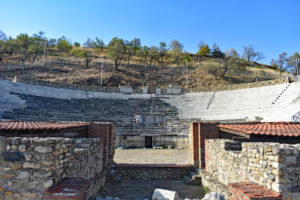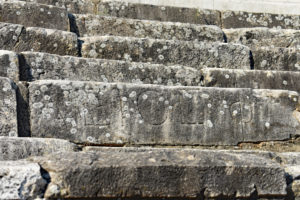Heraclea Lyncestis is an ancient city, near Bitola, which we visited on our journey between Lake Ohrid in North Macedonia and “Korça”:https://www.silvertraveladvisor.com/review/attraction/200720-review-sight-seeing-in-kor-a Korce in “Albania”:https://www.silvertraveladvisor.com/blog/destination-features-europe-albania/albania. It was founded in the middle of the 4th century by King Philip II of Macedon and was occupied until the 6th century when the Slavs invaded and there was an earthquake.
On arrival we were pleased to see a bus with a large group leaving which meant we had the site virtually to ourselves. Our allocated guide, Goran, was excellent and bearing in mind, we’d already spent the morning at the ruins of “Stobi”:https://www.silvertraveladvisor.com/review/attraction/203456-review-stobi-archaeological-site and enjoyed a “wine tasting lunch”:https://www.silvertraveladvisor.com/review/attraction/203464-review-tikve-wine-vaults, we were pleased to find a relatively small, compact site.
Due to a lack of funding, only 10% to 15% of the city is uncovered and around 80% of that was excavated in the 1980s and 1990s. The name honours the mythical hero, Heracles, with Lyncestis being the name of the ancient kingdom conquered by King Philip II.
The city had natural protection with the Baba Mountain in the north and the river Siva Voda in the south. The three periods were: Ancient Macedonians, Romans and early Christians.
The site map highlighted eight areas: (1) courthouse portico, (2) street and sewer system, (3) thermal baths, (4) small basilica, (5) great basilica (6) episcopal residence, (7) fountain and (8) amphitheatre. Areas 1, 2 and 8 were constructed in the Roman period and the others in the Christian period.
Walking down the street, we had the courthouse portico on our right-hand side. There were two plinths and although one was empty, the other had a statue, said to be Nemesis, the goddess of justice and fate, identified by the scale and bow, the attributes of truth and justice.
Large arches in the walls would have been shops, as the city was an important trading centre with the main Roman road, Via Egnatia, running through it.
The thermal baths, across the street from the courthouse, were an impressive building consisting of the: frigidarium, the unheated room for a cold plunge; tepidarium, a room at an intermediate temperature; and caldarium, a sweating-room with a plunge bath. We could see the remains of the brick columns on which the floor was built, this allowed hot air to circulate through the spaces which heated the water.
The small basilica was discovered in excavations made before the outbreak of WWII between 1936 and 1938. Here we learned about the two types of techniques used to create the mosaic floors – ‘opus sectile’ where the mosaic pieces are cut to fit the design, and ‘opus tessellatum’ which uses uniform square shaped tiles.
The four rectangular-shaped mosaics in the great basilica, covered 100 square meters and were well preserved. The subjects were connected to Christianity and 25 colours were used. On the top row were images of paradise, fruits, animals and birds, including deer and peacocks, a sign of eternity. The central layer depicted battles between good and evil, whilst the bottom had water-related images, fish and Medusa. There were also swastika like images with no beginnings or ends. A dog and tree mosaic from the floor of the great basilica is depicted on the reverse of the Macedonian 5000 Denar note.
Goran told us that the Macedonian climate can vary 70 degrees with temperatures reaching as low as -25 in winter, and 45 degrees in summer. For this reason, the mosaics are covered in winter by sand for protection.
On route to our final stop, the horseshoe-shaped amphitheatre, we passed the fountain, built in 562 by the bishops. There are three other theatres in Macedonia: (1) “Stobi”:https://www.silvertraveladvisor.com/review/attraction/203456-review-stobi-archaeological-site (the largest), (2) Ohrid (which we were going to see), and (3) Skupi, the only one we didn’t visit. This one had a capacity of 3,000 with 6 rows of 500 seats. Some of the seats had been inscribed by what Goran described as ‘season ticket holders’. It had been created between the 1st century BC and 2nd century AD in the late Hellenic/early Roman period. When Christianity was accepted and the gladiatorial combat stopped, some of the stones were moved from the amphitheatre to the basilica.
Although the vast majority of the site is still to be uncovered, our visit was relatively short, but entertaining and the perfect end to a busy day.










